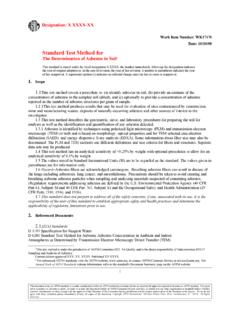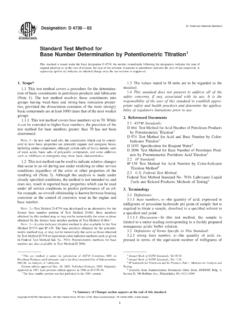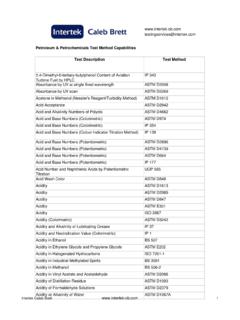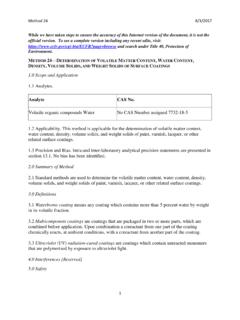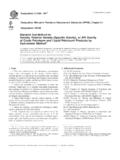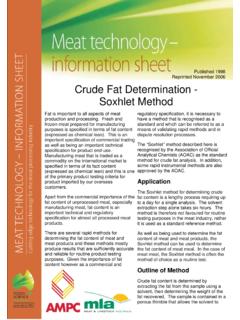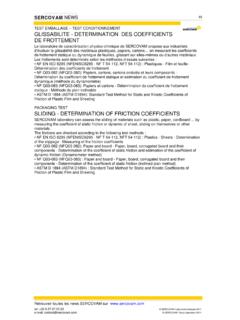Transcription of METHOD 5 DETERMINATION OF PARTICULATE …
1 METHOD 5 8/2/2017 1 While we have taken steps to ensure the accuracy of this Internet version of the document, it is not the official version. The most recent edits to this METHOD were published here: To see a complete version including any recent edits, visit: and search under Title 40, Protection of Environment. METHOD 5 DETERMINATION OF PARTICULATE MATTER EMISSIONS FROM STATIONARY SOURCES NOTE: This METHOD does not include all of the specifications ( , equipment and supplies) and procedures ( , sampling and analytical) essential to its performance. Some material is incorporated by reference from other methods in this part. Therefore, to obtain reliable results, persons using this METHOD should have a thorough knowledge of at least the following additional test methods : METHOD 1, METHOD 2, METHOD 3.
2 Scope and Application Analyte. PARTICULATE matter (PM). No CAS number assigned. Applicability. This METHOD is applicable for the DETERMINATION of PM emissions from stationary sources. Data Quality Objectives. Adherence to the requirements of this METHOD will enhance the quality of the data obtained from air pollutant sampling methods . Summary of METHOD PARTICULATE matter is withdrawn isokinetically from the source and collected on a glass fiber filter maintained at a temperature of 120 14 C (248 25 F) or such other temperature as specified by an applicable subpart of the standards or approved by the Administrator for a particular application. The PM mass, which includes any material that condenses at or above the filtration temperature, is determined gravimetrically after the removal of uncombined water.
3 Definitions [Reserved] Interferences [Reserved] Safety Disclaimer. This METHOD may involve hazardous materials, operations, and equipment. This test METHOD may not address all of the safety problems associated with its use. It is the responsibility of the user of this test METHOD to establish appropriate safety and health practices and to determine the applicability of regulatory limitations prior to performing this test METHOD . Equipment and Supplies Sample Collection. The following items are required for sample collection: METHOD 5 8/2/2017 2 Sampling Train. A schematic of the sampling train used in this METHOD is shown in Figure 5-1 in section Complete construction details are given in APTD-0581 (Reference 2 in section ); commercial models of this train are also available.
4 For changes from APTD-0581 and for allowable modifications of the train shown in Figure 5-1, see the following subsections. NOTE: The operating and maintenance procedures for the sampling train are described in APTD-0576 (Reference 3 in section ). Since correct usage is important in obtaining valid results, all users should read APTD-0576 and adopt the operating and maintenance procedures outlined in it, unless otherwise specified herein. Probe Nozzle. Stainless steel (316) or glass with a sharp, tapered leading edge. The angle of taper shall be 30 , and the taper shall be on the outside to preserve a constant internal diameter. The probe nozzle shall be of the button-hook or elbow design, unless otherwise specified by the Administrator.
5 If made of stainless steel, the nozzle shall be constructed from seamless tubing. Other materials of construction may be used, subject to the approval of the Administrator. A range of nozzle sizes suitable for isokinetic sampling should be available. Typical nozzle sizes range from to cm (1 8 to 1 2in) inside diameter (ID) in increments of cm (1 16 in). Larger nozzles sizes are also available if higher volume sampling trains are used. Each nozzle shall be calibrated, according to the procedures outlined in section Probe Liner. Borosilicate or quartz glass tubing with a heating system capable of maintaining a probe gas temperature during sampling of 120 14 C (248 25 F), or such other temperature as specified by an applicable subpart of the standards or as approved by the Administrator for a particular application.
6 Since the actual temperature at the outlet of the probe is not usually monitored during sampling, probes constructed according to APTD-0581 and utilizing the calibration curves of APTD-0576 (or calibrated according to the procedure outlined in APTD-0576) will be considered acceptable. Either borosilicate or quartz glass probe liners may be used for stack temperatures up to about 480 C (900 F); quartz glass liners shall be used for temperatures between 480 and 900 C (900 and 1,650 F). Both types of liners may be used at higher temperatures than specified for short periods of time, subject to the approval of the Administrator. The softening temperature for borosilicate glass is 820 C (1500 F), and for quartz glass it is 1500 C (2700 F).
7 Whenever practical, every effort should be made to use borosilicate or quartz glass probe liners. Alternatively, metal liners ( , 316 stainless steel, Incoloy 825 or other corrosion resistant metals) made of seamless tubing may be used, subject to the approval of the Administrator. Pitot Tube. Type S, as described in section of METHOD 2, or other device approved by the Administrator. The pitot tube shall be attached to the probe (as shown in Figure 5-1) to allow constant monitoring of the stack gas velocity. The impact (high pressure) opening plane of the pitot tube shall be even with or above the nozzle entry plane (see METHOD 2, Figure 2-7) during sampling. The Type S pitot tube assembly shall have a known coefficient, determined as outlined in section of METHOD 2.
8 Differential Pressure Gauge. Inclined manometer or equivalent device (two), as described in section of METHOD 2. One manometer shall be used for velocity head ( p) readings, and the other, for orifice differential pressure readings. METHOD 5 8/2/2017 3 Filter Holder. Borosilicate glass, with a glass or Teflon frit filter support and a silicone rubber gasket. Other materials of construction ( , stainless steel or Viton) may be used, subject to the approval of the Administrator. The holder design shall provide a positive seal against leakage from the outside or around the filter. The holder shall be attached immediately at the outlet of the probe (or cyclone, if used). Filter Heating System. Any heating system capable of monitoring and maintaining temperature around the filter shall be used to ensure the sample gas temperature exiting the filter of 120 14 C (248 25 F) during sampling or such other temperature as specified by an applicable subpart of the standards or approved by the Administrator for a particular application.
9 The monitoring and regulation of the temperature around the filter may be done with the filter temperature sensor or another temperature sensor. Filter Temperature Sensor. A temperature sensor capable of measuring temperature to within 3 C ( F) shall be installed so that the sensing tip of the temperature sensor is in direct contact with the sample gas exiting the filter. The sensing tip of the sensor may be encased in glass, Teflon, or metal and must protrude at least 1 2 in. into the sample gas exiting the filter. The filter temperature sensor must be monitored and recorded during sampling to ensure a sample gas temperature exiting the filter of 120 14 C (248 25 F), or such other temperature as specified by an applicable subpart of the standards or approved by the Administrator for a particular application.
10 Condenser. The following system shall be used to determine the stack gas moisture content: Four impingers connected in series with leak-free ground glass fittings or any similar leak-free noncontaminating fittings. The first, third, and fourth impingers shall be of the Greenburg-Smith design, modified by replacing the tip with a cm (1 2 in.) ID glass tube extending to about cm (1 2 in.) from the bottom of the flask. The second impinger shall be of the Greenburg-Smith design with the standard tip. Modifications ( , using flexible connections between the impingers, using materials other than glass, or using flexible vacuum lines to connect the filter holder to the condenser) may be used, subject to the approval of the Administrator.










